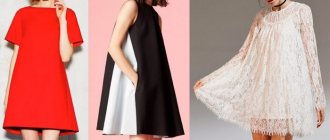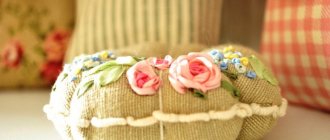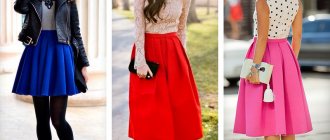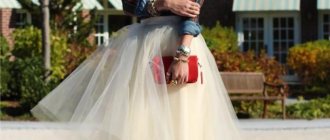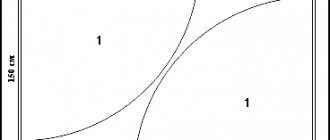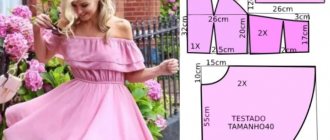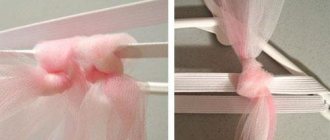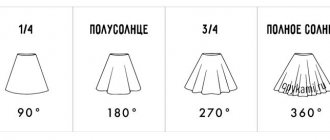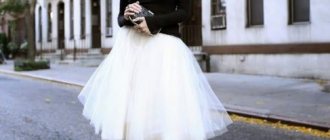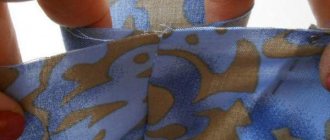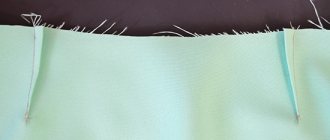Who is the style suitable for?
The peculiarity of the shape of the skirt is a visual reduction in the volume of the waist, hips and lengthening of the legs. These undoubted advantages make the model especially attractive to women of different ages and body types. “Trapezoid” suits young and slender girls with a model figure and those in the Plus size category.
An “A” silhouette skirt looks equally good on tall and thin girls in the “mini” version and on women with curvy figures of short stature in the “midi” and “maxi” versions.
Recommendations for women of different body types and age groups:
- For young and slender girls, the skirt can be “mini” or “midi”. The product can be with a tight fit at the waist, as well as with pleats or gathering at the waist and hips. The “maxi” option is not recommended for everyday wear and is only suitable for exceptional occasions.
- For women with an hourglass body type, as well as for curvy figures with the correct proportions (“Rubensian” type), A-line skirts with a length to the knee line or slightly below it are suitable. The style of the skirts should not be overloaded with excess volume in the hips; infrequent vertical folds or “wrap” are recommended.
- For women of small stature with a lower body type (“pear”), the ideal solution would be an “A-line” skirt with a tight fit at the waist without yokes or horizontal undercuts. Additional volume in the hip area in the form of gathers and folds should be excluded. The optimal skirt length for this category of women is just above the knee, to the middle of the knee, “French” length.
In order not to violate the correct proportions, the length of the A-line skirt should visually be greater than the width of the hips. The “A-line” skirt is a universal item of women’s wardrobe; it can be combined with almost any top, from simple cotton T-shirts to jackets, short coats and short fur coats.
This ideal belt item can be perfectly combined with blouses, T-shirts, turtlenecks or warm sweaters. The main thing is that this combination is correct in style, color and shape.
Shoes for an A-line skirt are selected depending on its length and according to the specific occasion. For example, to create an image with a short skirt, high-heeled shoes are suitable, and for a maxi skirt, a combination with flat shoes or solid soles - sandals, ballet flats, light summer slippers, Romans or clogs - will be very organic.
Peculiarities
The birthplace of the kilt (circular pleated skirt) is Scotland. Initially, clothing was intended exclusively for male warriors. It did not restrict movement in battles and did not interfere with horseback riding. To this day, a checkered skirt with circular pleats is considered the national clothing of the Scots.
Later, women noticed the unusual cut. Today, pleated skirts are actively used in a variety of stylistic looks.
Upon careful examination, it becomes clear that folds are distinguished by the method of smoothing:
- one-sided - bookmark in a certain direction;
- counter - folds are smoothed towards each other;
- bow - tucks “look” in different directions.
In essence, counter pleats and bow pleats are similar to each other. It all depends on which side you look at them from. So, the counter fold placed along the face of the product turns into a bow, you just have to turn the skirt inside out.
In addition, there are group, single, straight, asymmetrical, fan folds. Tucks are made of different depths (narrow/wide) and in any quantity. The folds are directed from the waistband to the edge of the hem. This skirt looks plastic and sways with amplitude while moving. Sometimes they are spent a few centimeters at the top. The length can also be arbitrary - from a mini to a floor-length skirt. Since pleated models belong to the category of classics, most often there are products up to the middle of the knee or midi.
Taking measurements and calculating fabric
Sewing a skirt begins with choosing a style, taking measurements and calculating the material.
Figure measurement
The pattern of an “A” silhouette skirt is made using a straight skirt design, for the construction of which the following measurements are required:
| Code name | Decoding |
| St | half waist circumference |
| Sat | semi-hip circumference |
| Wb | hip height |
| Di | length of the product |
To make a skirt design with an offset waist, additional measurements are taken - a new waist line is marked on the figure with a visual horizontal line (optional) and measurements are taken using this guideline.
A-line skirt. Pattern: First you need to determine the size.
In addition to absolute measurements, to draw a design drawing you will need increases for freedom of fit at the waist (Pt) and at the hips (Pb). These values are constant and change only in connection with fashion trends in clothing design.
Fabric calculation
To calculate the fabric for a skirt, 2 measurements are taken - the length of the product and the circumference of the hips. Measuring the semi-circumference of the hips (Sb) is necessary in order to calculate whether the finished skirt patterns will fit at a certain fabric width. The length of the skirt (Di) is necessary in order to calculate the required consumption of a piece of fabric for the shaped length of the skirt, taking into account all the cutting details with allowances, with a reserve of fabric for spreading the patterns.
Approximate calculation of fabric with a fabric width of 150.0 cm for an A-line skirt for a figure with a hip volume of 120.0 cm:
Estimated length of the piece = 90.0 cm (Di in g/v) + 15.0 cm (waist allowance) + 4.0 cm (bottom hem) + 10.0-20.0 cm (reserve for other allowances and expansion patterns) = 120.0-125.0 cm.
In addition, when calculating the fabric, you need to take into account the direction of the warp thread (when cutting “on the bias” there is a completely different method of calculation), the direction of the pattern (check, strip or coupon) and the width of the fabric. For example, with a canvas width of 110.0-130.0 cm, the estimated length of the piece is increased by 2 times.
What it is
Most women's skirts have a yoke. Moreover, some girls wearing such products do not even know about the presence of this element on their clothes; such an outfit will literally hide all the imperfections of the figure in a minute.
Huge color range of styles
A yoke is a cut piece that serves as an element of clothing. This is nothing more than a belt of a unique cut, sewn to the main fabric of the skirt. Yoke is present not only in skirts, but also in dresses and trousers. The manufacturer must indicate on the label the full length of the product, including the yoke.
Pattern base
To construct a skirt of any style, including “A-Line,” the design of a classic straight skirt is used.
On this basic basis, through modeling, you can sew a large number of different models:
- pencil skirt;
- skirt with buttons (clasp);
- skirt “balloon”, “tulip”;
- wrap skirt;
- skirt with pleats and yokes.
Step-by-step implementation of the base design:
Note: Raise the “T₂” point vertically upward by 1.0-2.0 cm. This is the difference between the length of the skirt from the floor in the middle of the front and the length of the skirt from the floor along the side seam.
To create an A-line skirt, the straight classic skirt patterns should be cut into 4 parts (see diagram above). Then, aligning the sides of the darts in pairs, open and spread the skirt along the bottom. The product can be created with additional volume by adding 3.0-10.0 cm to both sides of the side seam along the bottom.
The layout of the patterns can be done in the opposite direction. However, then you need to take into account the location of the pattern or shade of the fabric.
The extension of the skirt should be formed by smooth curved lines along all seams of the product.
How to sew it yourself
A wraparound skirt with ties, the pattern of which is almost completely similar to a circle skirt, is considered simple in terms of tailoring. Quick sewing is done as follows:
- Prepare a piece of fabric with a width of 70 cm and a length of 1.2-1.5 m.
- Fold the fabric several times.
- Cut the corner under the waist.
- Make the bottom semicircular.
- Sew strips that will serve as ties for the skirt.
- Process textile sections.
You might be interested in: Rules for sewing diapers for newborns yourself
Sewing without a pattern
An easy manufacturing option using the half-sun technique takes little time.
Textile
A-line skirts are made from absolutely any material. The choice of material depends on the season, the desired image, purpose and personal preference of the woman.
Denim
Jeans items rarely go unclaimed in the wardrobe, and denim skirts even more so. This is a practical and especially popular item among women of any age and body type. Denim A-line skirts of any length can be used all year round as casual or work wear.
They go with any top and almost any shoe, from simple beach flip-flops to long leather over the knee boots or wide-top ankle boots.
Leather
The “Trapezoid” skirt (the pattern above is also suitable for leather) can be sewn from a natural sheet of leather, from high-quality elastic leatherette, eco-leather or suede. Leather products have always been considered an item of special luxury, due to the characteristics of the material, its plasticity and high aesthetic qualities.
The A-line skirt made of leather perfectly fits the figure at the waist and upper hips, and the flaring downwards forms beautiful tails and hides all the imperfections of the physique.
Knitted
Knitted A-line skirts are loved by most women of all ages. They are comfortable, fit perfectly and are very practical. Skirts made of thin or thick (voluminous) knitwear are all-season. They are combined with light blouses and T-shirts, as well as with warm sweaters and turtlenecks.
Depending on the style, A-line knitted skirts are worn with solid-soled shoes, sandals, open sandals, ballet flats, high-heeled shoes, and in winter - with high boots, ankle boots, ankle boots or duttons.
Silk
Silk A-line skirts are preferred by romantic people. Light, playful models in the “mini” version are preferable for young girls. The property of the fabric involves the use of numerous folds, flounces or ruffles. Options for silk midi and maxi skirts fit perfectly into the summer wardrobe of older ladies.
Models of A-line silk skirts are combined with simple T-shirts, blouses, and light cotton turtlenecks.
Chiffon
Flying, spectacular chiffon skirts give a woman a special mood. They are perfect for creating a mysterious, romantic image. Chiffon A-line skirts are made with an oblique cut, multi-layered, with abundant ruffles and flounces.
The look with an airy chiffon skirt will go well with stylish sandals or high-heeled pumps.
We compose ensembles
Checkered A-line skirts go well with different top options, so fashionistas won’t have to rack their brains for long about what to wear with the purchased model.
The most important rule when putting together ensembles: the skirt should play a leading role in it. This means that the remaining elements should not be too flashy.
As the top element of the ensemble, stylists recommend choosing:
- turtleneck;
- sweater or jumper made of fine knitwear;
- top - with or without sleeves;
- a classic or romantic style blouse;
- plain shirt.
It is not recommended to wear sports-style T-shirts, plaid cowboy shorts, or voluminous sweatshirts with plaid skirts. The color of the top of the ensemble can be neutral or repeat one of the colors of the checkered pattern.
You can complement the ensemble with a short jacket (denim or leather), a fitted jacket or a short cardigan. Accessories should be feminine. Elegant handbags, berets, and elegant jewelry go well with plaid skirts.
Length
The “A-line” skirt (the pattern of the model is presented above) is good in any length. Thin, slender girls and women can afford any skirt length - in any version, the skirt will look great on such a figure. For women of average build and plus size, a length below the knee and a floor-length skirt is suitable.
Short
The mini skirt is suitable for girls, teenagers and young girls with beautiful slender legs and narrow hips. The “A” silhouette visually enlarges the hip area, and models with yokes, pleats, gathers at the waist or from the hip completely hide this deficiency.
For short A-line skirts, poplin, silk, chiffon, woolen or suit fabric, leather, and suede are recommended.
Midi
A midi skirt is a universal wardrobe item for any woman. This model does not cover the entire figure, which means it will not look too bulky on a fuller figure.
At the same time, the skirt fits tightly to the waist and, due to the flaring towards the bottom, hides the excess volume of the hips and legs. Well-chosen tops, shoes and accessories make the look very feminine and stylish.
Long
The long A-line skirt is a more festive, evening version of the product, which will add elegance, femininity and romanticism to the image.
This outfit is more suitable for tall women, as a floor-length skirt visually reduces height and increases the figure in the hips.
Ensemble with a-line skirt
The advantage of a skirt is that it can be worn with blouses, tops, shirts or sweaters. It is suitable for both work and going to a holiday. To create a casual look for a walk or an evening date, you can choose a bright T-shirt, tank top or top with straps.
Summer model
You can emphasize elegance with a short blouse, a T-shirt with a revealing neckline, or a tight-fitting sweater - such things visually make the figure slimmer. Shoes for such a skirt must be chosen, taking into account the place in which it will be worn. For a holiday or birthday, you can safely wear heels of any height; if the skirt is very short, then the heel should be as high as possible to emphasize the legs. This image will effectively highlight the tenderness and slimness of the figure. If you need to wear a skirt to the office or for a walk, it is better to use ballet flats or sneakers.
In conclusion, it should be noted that sewing such a skirt yourself is quite simple. It can be worn by girls of any figure and height. If you choose the right clothes, a regular A-line skirt can create a perfect and graceful look.
With elastic band
The “Trapezoid” skirt (the pattern for the model with elastic is given below) is a comfortable and beautiful thing at the same time that you can sew with your own hands, even without any special sewing skills. These skirts can be of different lengths. Short skirts with elastic are suitable for girls, teenagers and young girls. Midi and maxi skirts are very popular among older women.
To create a pattern for a skirt with an elastic band, you will need the same patterns for the basics of a classic straight skirt. Next, as a result of modeling on paper or directly on fabric, the skirt is cut out taking into account the necessary seam allowances.
The pattern of an a-line skirt with an elastic band is constructed as follows:
- Cut the patterns for the base of the straight skirt along the verticals, lowered from the ends of the darts of the front and back halves of the skirt.
- Place the resulting parts of the base on a large piece of paper or fabric. To begin, align both halves together in pairs, and then move the patterns apart to the required assembly size.
- Trace the patterns and decorate the waist, bottom and side seam lines with smooth curved lines.
For a midi skirt (pattern No. 1) with a moderate volume of elastic, the spread of the patterns can be from 5.0 to 12.0 cm. For a mini skirt (pattern No. 2) with a medium volume of gathering under an elastic band, this value can be increased due to additional expansion of the side seam (≈ 20.0 cm in total).
A short skirt with an elastic band with a large volume at the waist (pattern No. 3) can be cut out with a straight line and with one connecting seam at the back.
The “Trapezoid” skirt with elastic has the following technological sewing sequence:
- Lay out the skirt pattern on the fabric, taking into account the direction of the main thread, the fold location and seam allowances.
- Make trimming of the skirt parts and seam allowances - 1.0 cm along the waist line, 1.5 cm along the side seam, 2.5 cm along the bottom of the skirt. Cut out the skirt parts.
- Pin paired side sections, stitch, overlock the sections and iron towards the back.
- Pin a belt folded in half to the top edge of the skirt. Having specified its length along the top, sew the short sides and stitch the waistband, leaving a small hole (1.0-1.5 cm) for threading the elastic. The elastic waistband can be made narrow or wide (several rows of rubber tape). To finish the top seam in such skirts, decorative wide elastic bands are used. A skirt with an elastic band can be sewn without a sewing belt. When sewing light natural silk, chiffon or organza, sewing rubber threads are used as an elastic band.
- Insert a rubber band into the belt and secure the ends.
- Finish the edge of the belt with an overlocker.
- Finish the bottom of the skirt with a hem seam with an open or closed cut.
How to make a belt
A yoke belt is a detail of a product with a belt (skirt, trousers, etc.), which performs several functions on clothing: a belt and a yoke.
Location: below the waist.
Belt pattern
Most often found on straight-cut products.
- From the top edge of the pattern of the back and front fabric, you need to set aside several 50 mm sections. 50 mm is the width of the yoke.
- The segments are laid at the top of the pattern base lines on the back and front fabric. On curves - at an angle of 90 degrees to the lines.
Attention! The greater the quantitative ratio of the postponed segments, the more accurate the lower edge of the yoke. It is not necessary to put the yoke on paper - the lower line of the belt is marked.
- The lower line is connected by segments at points.
- A curve that follows the shape of the top edge of the parts.
- The top edge of the front and back panel pattern is trimmed.
- The scattered parts of the belt are glued end to end.
- The details of the belt are corrected - a smooth shape of the part is drawn.
The details of the yoke belt are outlined on a piece of paper.
With buttons
An interesting idea in the design of the A-line skirt was the use of button closure. In this case, buttons are not only necessary accessories for fastening, but also an element of decorative finishing of the skirt. The button closure can be located on the front, side or back.
A modern print has become the use of large buttons of a contrasting color on mini skirts made of suit fabrics and, vice versa, small fittings in 1 or 2 rows in the main tone of the fabric.
Is it possible to sew without using patterns?
There are models that even a novice seamstress can make. A regular beach-style straight skirt is an elementary type that does not require a cut. How to sew a wrap skirt without a pattern:
- You need to prepare a piece of fabric. The length of the fabric will correspond to the length of the skirt.
- The length of the strip must be at least 1.5 m.
- You just need to process the sections of fabric and sew on a strip belt, which will become ties for molding the wrap.
Sewing without measurements and patterns
There is no need to cut in this situation. The main thing is to carefully finish the parts that will make up the product.
With smell
An interesting trend of the last season was the A-line wrap skirt. Buttons, wide “bow” belts, and all kinds of buckles or brooches are used as retaining accessories in such products. The piquant feature of the wraparound model is the beveled upper half of the skirt and the bottom with a corner.
Skirts made of thick suiting or woolen fabric are trimmed with contrasting trim along the length of the wrap, gold or silver decorative buttons and braid.
Processing technology
To make the skirt look attractive and not unravel after the first wear or wash, you need to take into account the processing technology:
- It is recommended to be sure to overcast all the cuts that were made at the time of preparing the pattern.
- You need to hem the hem of the skirt with a hidden seam to remove unattractive cuts.
- When sewing the parts together, you should carefully iron the internal seams.
Pre-processing
A detailed description of such actions is not required, since each model is unique in its own way, and, therefore, the patterns need to be processed differently.
Pleated
The “A-line” skirt model with pleats – deep, textured or small, “pleated” – always remains in demand. Pleated skirts are suitable for creating a romantic look and a business suit.
Skirts made from thick suit fabrics are made for work or school, for example, for schoolgirls during the fall-winter period. Fluffy and light skirts for summer are made from airy fabrics - silk, chiffon, organza or satin.
For many years, the A-line skirt has been a favorite model of women. Based on the classic straight skirt (the pattern is presented above), you can create a whole family of “A”-line skirts with your own hands. The shape of the skirt is suitable for creating an image of any style, for any season and for all categories of women.
Author: Severyanochka
What is the best material to sew from?
Fabrics
When sewing clothes, they mainly use soft and loose materials that are easily ironed and hold their shape well. For example, a circle skirt with counter pleats is best made from satin, silk and cotton or wool based fabrics. Heavy flowing velvet is very popular. It makes luxurious long skirts with counter pleats, which are perfect for creating evening looks.
Products with multiple deep folds look impressive. To sew them, you need to buy twice as much fabric as for standard two-seam models. This significantly increases the cost of the final product. But the non-trivial style and universal purpose completely compensate for any costs. If a skirt with counter pleats is in her wardrobe, a woman feels confident in any life situation.
Colors
Skirts can be dyed in a wide variety of colors. Regarding prints, it has been noticed that pleated models greatly limit their use. The reason is the distortion of the main pattern, which inevitably occurs when smoothing pintucks. The only print option that has no restrictions is the traditional check. Moreover, a design with thin lines and wide stripes looks equally good.
You can also choose a fabric with a coupon placed horizontally at the bottom of the skirt. However, this option is not suitable for all women, because it visually expands the shape and reduces height.
